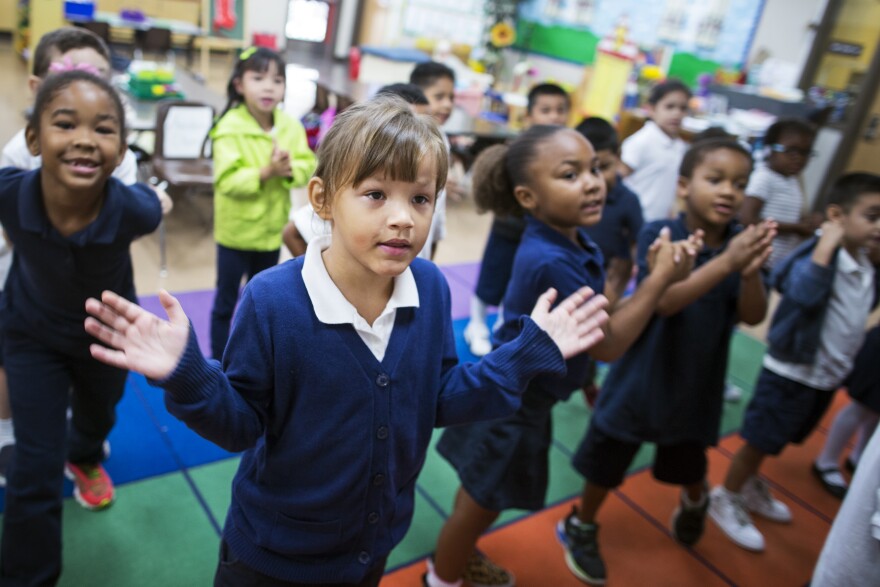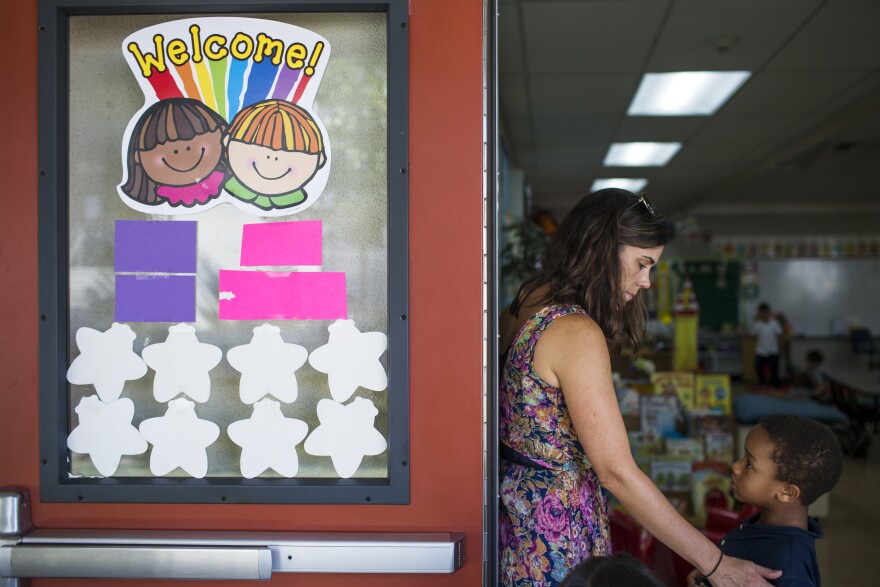Congress has cut federal funding for public media — a $3.4 million loss for LAist. We count on readers like you to protect our nonprofit newsroom. Become a monthly member and sustain local journalism.
The battle over what it really means to be ready for kindergarten
A dribble of water from a thick hose slowly fills Jackson Feola’s creation in the sandpit at the Sierra Madre Community Nursery school. He’s slapping wet sand onto the outer edges of his foot-high mound to reinforce it. “I’m playing in mud,” the four-year old said grinning, too busy to stop for an interview.
His legs and arms are caked in wet sand, and as he shoveled, he warned that his volcano might erupt any minute.
Feola will start kindergarten next year. He loves building volcanoes – and trenches, waterways, rivers, bridges, ponds and moats – in the sandpit. And even though he knows a lot about all of these structures, he couldn’t name the letter "volcano" starts with.
But does that matter?
In the debate over what constitutes “kindergarten readiness,” some educators believe it's important that preschoolers learn basic letters and letter sounds. The U.S. Department of Education’s Early Childhood Longitudinal Study (ECLS) uses this approach, for example, to gauge how ready children are for kindergarten. It looks at skills like letter recognition and the ability to sound out words to test early literacy.
For other educators – such as those who run Feola’s preschool – unstructured, child-directed play is a more age-appropriate way to prepare preschoolers for the challenges that will face them in elementary school.
Academics in preschool
Sandpit immersion has not been a common teaching strategy across publicly-funded preschools, where children spend more time at a desk and where children might be taught how to be a good friend through filling out a worksheet.
“Kindergarten is very demanding,” said Donna Garcia, a veteran early educator at Arminta Early Education Center. It's been well documented that kindergarten has evolved to cover content that first grade did a decade ago. Garcia's students come from low-income families, and many are English language learners. She doesn’t want them to be the children who fall behind in school.
Garcia does her best to incorporate play times for her students, and she focuses a lot on early literacy. “We do journaling, we do dictation, we have a writing table, we incorporate writing through all areas,” Garcia said.
She wants her preschoolers to see the act of writing as something they can, and should, be doing. So she placed “clipboards and notebooks in all areas of the classroom.”
At Child Fair Early Education Center, preschool teacher Karina Ceja said she feels a pressure to have her students leave preschool “knowing the complete alphabet, knowing the numbers.”
For Ceja, this meant “a lot more drilling” of preschoolers so they would be ready for the higher academic demands of kindergarten.
Martha Borquez, director of early education for LAUSD, understands the pressures her teachers feel to have their preschoolers learn basic academics.
Borquez used to run a district early education center, and would begin the school year by asking kindergarten teachers what they wanted her preschool teachers to focus on so the kids would be prepared. The list she would get was long: Know their letters, write words and even read and write sentences, Borquez said.
Yet when Borquez would consult the kindergarten and first grade standards, she found teachers were expecting 4-year-olds to be learning skills slated for these higher grades.
“We realized that all the skills they wanted our kids to come in [to kindergarten] knowing are the skills that were taught in K through 12,” Borquez said.
The prevailing preschool standards that the California Department of Education asks its programs to follow only require that preschoolers recognize “more than half” of the letters of the alphabet, for example. These same standards also begin with a focus on social and emotional learning – like how to communicate feelings, for example – not literacy or numeracy.
Borquez and other district leaders have rolled out a new early learning curriculum to promote play-based and creative learning. She said she wants her preschoolers to have a more playful school experience and also be introduced to academics.
Sandpit immersion
At Jackson Feola's preschool in Sierra Madre, there is no pressure to meet standards, said veteran teacher Eileen Lucas. Her view is that making a preschool-aged child sit in a desk and learn to write letters and numbers is not developmentally appropriate.
“They’re supposed to be moving their bodies and learning about the world around them, and interacting with each other, [learning] how to negotiate social activities,” she said. Research supports her view that children learn through play.
Lucas said her students have a sophisticated understanding of things they are interested in, even if they are not yet reading or writing. What 4-year-old Feola could articulate about volcanoes, for example, aligns with what students will learn – as per the National Science Education Standards – when they are in 5th grade.
“If the children are given enough time to play when it’s time sit in a desk they will be ready to,” Lucas said. “This isn’t what they are supposed to be doing at three and four and five [years old.]”
At preschools like this, there are no letters or numbers of the day, no worksheets that help kids write or read. Lucas worries that these teaching strategies lead to preschoolers being “burnt out” by the time they get to kindergarten, and she does not feel any pressure to have her students reading or writing by the time they head to kindergarten.
A third way
Pasadena teacher Cherie Wood said that it doesn’t have to be an either-or decision when it comes to play versus early academics.
In her transitional kindergarten class at Willard Elementary school, Wood used play and creative learning techniques that slipped in the letters and numbers, but without repetitive worksheets.
“We would do letters with play-doh, with shaving cream, with 'Wikki Stix,'” Wood said. Kids loved it, but inside the fun, Wood said, her priority was not academics.
“My biggest goal is that they’re socially, emotionally ready,” she said. So she geared her activities towards “really focusing on engaging with their peers, [and] being able to use their words and speak up for their needs and their wants.”
Kids with these skills, Wood said, will be ready for the academic rigors of kindergarten.
This year, Wood is putting her own pre-kindergarten methods to the test: now she’s teaching kindergarten. It’s a different vibe than her transitional kindergarten class of 4-year-olds last year.
“In kindergarten, we do start academics on first day,” Wood said. “But we take things a lot slower.”
Her class this year is made up of some of her own TK students from last year, some kids who did not attend preschool at all, and other children who went to a variety of preschools.
“I see some kids that come from more academic-based preschools, [and] yes, they know their letters and sounds, they’re starting to read and write, but they haven’t had the opportunity to play as much, so it does affect the flow of the classroom,” Wood said.
The children who haven’t learned how to interact with other children or how to self-calm, for example, make her job as a kindergarten teacher harder. “It might take us longer to do something because we have to stop and remind little Johnny the appropriate way to sit or to keep his hands to himself," she said.
To help all her kindergarten students, Wood still includes playtime inside the classroom. So when they use play-doh to make the letter of the day, then they have free time with the squishy ball of dough to create whatever they want.
And the ensuing sounds of squealing and giggling reassure Wood that her students are eager and learning.
--------
Deepa spoke with Stanford Graduate School of Education (GSE) Professor Sean Reardon, co-author of a recent study which found that the achievement gap between rich and poor kindergarteners has narrowed
As Editor-in-Chief of our newsroom, I’m extremely proud of the work our top-notch journalists are doing here at LAist. We’re doing more hard-hitting watchdog journalism than ever before — powerful reporting on the economy, elections, climate and the homelessness crisis that is making a difference in your lives. At the same time, it’s never been more difficult to maintain a paywall-free, independent news source that informs, inspires, and engages everyone.
Simply put, we cannot do this essential work without your help. Federal funding for public media has been clawed back by Congress and that means LAist has lost $3.4 million in federal funding over the next two years. So we’re asking for your help. LAist has been there for you and we’re asking you to be here for us.
We rely on donations from readers like you to stay independent, which keeps our nonprofit newsroom strong and accountable to you.
No matter where you stand on the political spectrum, press freedom is at the core of keeping our nation free and fair. And as the landscape of free press changes, LAist will remain a voice you know and trust, but the amount of reader support we receive will help determine how strong of a newsroom we are going forward to cover the important news from our community.
Please take action today to support your trusted source for local news with a donation that makes sense for your budget.
Thank you for your generous support and believing in independent news.

-
The bill would increase penalties for metal recyclers who possess or purchase metal used in public infrastructure.
-
The new ordinance applies to certain grocers operating in the city and has led to some self-checkout lanes to shutter.
-
Children asked to waive right to see a judge in exchange for $2,500
-
There’s still a lot to be determined as the refinery, which supplies about one-fifth of Southern California's vehicle fuels, works to restore production and as data is collected.
-
The FCC voted to end E-Rate discounts for library hotspot lending and school bus Wi-Fi.
-
About half the Pacific Airshow’s 2025 lineup has been grounded because of the federal government shutdown.

















